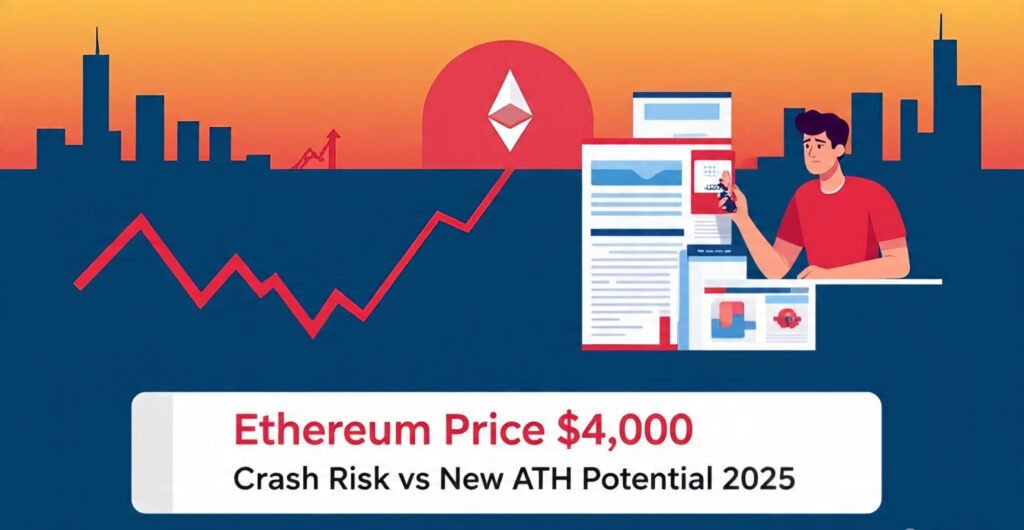The Ethereum price currently sits at a pivotal moment in its market trajectory, with the live Ethereum price today trading around $4,295 as investors and analysts debate whether the world’s second-largest cryptocurrency will experience a significant correction or break through to establish new all-time highs. As market sentiment remains divided, technical indicators and on-chain data provide crucial insights into ETH’s immediate future.
The Cryptocurrency Market has witnessed tremendous volatility throughout 2024 and into 2025, with Ethereum demonstrating both resilience and vulnerability in equal measure. Recent market analysis suggests that while the market is leaning bullish, the bulls still have a relatively weak hold, meaning it could go sideways at any point. This delicate balance between bullish momentum and bearish pressure has created a fascinating scenario where both a crash to $4,000 and a surge to new heights remain realistic possibilities.
Understanding the current Ethereum price prediction requires examining multiple factors, including technical analysis, market sentiment, institutional adoption, and broader crypto market trends. As we delve deeper into this analysis, we’ll explore the various scenarios that could unfold and what they mean for both short-term traders and long-term investors in the ETH ecosystem.
Current Market Position and Technical Analysis
Support and Resistance Levels
The Ethereum price currently trades within a critical range that could determine its short-term trajectory. If ETH breaks below the $4,222 support level – which looks increasingly likely given the selling pressure – we could see a swift drop to $4,007. This represents approximately a 10% decline from current levels and would bring ETH dangerously close to the psychological $4,000 support zone.
Technical analysts have identified several key levels that will be crucial for Ethereum’s immediate future:
Key Support Levels:
- $4,222 (immediate support)
- $4,000 (major psychological support)
- $3,800-$3,900 (secondary support zone)
Key Resistance Levels:
- $4,400-$4,500 (immediate resistance)
- $4,800-$5,000 (major resistance zone)
- $5,200+ (breakout territory)
Moving Average Analysis
The Ethereum price chart reveals interesting dynamics when examining moving averages. On the four-hour time frame, Ethereum is currently trending bullish with the 50-day moving average currently sloping up. However, this bullish signal is being challenged by increasing selling pressure and market uncertainty.
The relationship between short-term and long-term moving averages suggests that ETH is at a crossroads. A decisive break above the 200-day moving average could signal the beginning of a new bullish trend, potentially leading to new all-time highs. Conversely, a breakdown below key moving average levels could accelerate the decline toward the $4,000 support level.
The Case for a Crash to $4,000
Selling Pressure and Liquidation Risks
One of the most significant threats to Ethereum’s current price stability comes from potential liquidation cascades. Data show that if the ETH price slips further under $4,000, cascading liquidations could put as much as $1.19 billion at risk. This massive liquidation potential creates a precarious situation where a relatively small price movement could trigger a significant downward spiral.
The crypto market has witnessed how quickly sentiment can shift, and Ethereum is not immune to these dynamics. Large-scale liquidations often create self-reinforcing cycles where falling prices trigger more liquidations, leading to further price declines.
Market Sentiment and Fear Factors
Current market sentiment indicators provide mixed signals about Ethereum’s immediate future. Technical indicators signal a bearish market sentiment, while the Fear & Greed Index is displaying a score of 51 (Neutral). This neutral to slightly bearish sentiment suggests that investors remain cautious about ETH’s short-term prospects.
Several factors contribute to the bearish sentiment:
Macroeconomic Concerns: Global economic uncertainty continues to weigh on risk assets, including cryptocurrencies.
Regulatory Uncertainty: Ongoing regulatory developments in major markets create additional pressure on crypto prices.
Competition: Increased competition from other blockchain networks challenges Ethereum’s market dominance.
Technical Breakdown Scenarios
From the current levels, the next major level would be the support at $4,000, pushing the Ethereum price toward the next major psychological level. If this support fails to hold, several technical analysts have identified potential downside targets.
Andrew Kang, founder of Mechanism Capital, even warned that ETH could crash toward $3,200–$3,600 if long positions keep getting liquidated. Such a scenario would represent a significant correction from current levels and would likely trigger widespread concern among Ethereum investors.
The Path to New All-Time Highs
Bullish Catalysts and Growth Drivers
Despite the crash risks, several factors support the possibility of Ethereum reaching new all-time highs. DeFi and NFT use cases expanded, while mainstream acceptance reinforced Ethereum’s status as a critical infrastructure in the digital finance ecosystem. This growing utility and adoption provide a strong fundamental foundation for future price appreciation.
The Ethereum ecosystem continues to evolve and attract institutional interest, with several key developments supporting long-term bullish sentiment:
Institutional Adoption: Increasing institutional interest in Ethereum and DeFi protocols provides sustained demand.
Network Upgrades: Ongoing improvements to the Ethereum network enhance scalability and reduce transaction costs.
DeFi Growth: The expanding decentralized finance sector continues to drive demand for ETH.
Price Targets and Predictions
Several prominent analysts and prediction models suggest that Ethereum could reach significant price milestones in the coming months. A weekly close above ~$4.85–$4.90K could drive Ethereum price to hit the $5.0–$5.2K range by September 7, 2025.
More optimistic predictions suggest even higher targets:
Crypto analysts expect that in October 2025, the ETH price might fluctuate between $4,031.32 and $4,791.87, with some models projecting ETH price, with a potential surg,e could hit $6,925 in 2025.
Technical Breakout Scenarios
The Ethereum price chart shows several potential breakout scenarios that could lead to substantial price appreciation. Changelly’s statistical models align with forecasting an ETH price target of $4,687 by September 5th and $5,203 by September 14th.
These projections are based on historical data patterns and technical analysis, though they carry medium confidence levels due to market volatility and external factors.
Market Dynamics and External Factors
Institutional Interest and ETF Impact
 The cryptocurrency market has been significantly influenced by institutional adoption and regulatory clarity. Ethereum ETF discussions and potential approvals continue to generate interest among institutional investors, potentially creating substantial buying pressure.
The cryptocurrency market has been significantly influenced by institutional adoption and regulatory clarity. Ethereum ETF discussions and potential approvals continue to generate interest among institutional investors, potentially creating substantial buying pressure.
Institutional interest in Ethereum extends beyond simple price speculation, with many recognizing the network’s utility and potential for long-term growth. This institutional backing provides a stabilizing influence during market downturns and can help support price levels during periods of uncertainty.
Network Activity and On-Chain Metrics
Ethereum network activity remains a crucial indicator of the platform’s health and future price potential. Metrics such as active addresses, transaction volume, and DeFi total value locked (TVL) provide insights into actual network usage and adoption.
Recent data shows continued growth in network activity, suggesting that Ethereum maintains its position as the leading smart contract platform despite increased competition from alternative blockchain networks.
Competition and Market Share
The blockchain ecosystem continues to evolve rapidly, with numerous competitors challenging Ethereum’s dominance. However, Ethereum has maintained its leading position in most key metrics, including developer activity, DeFi market share, and institutional adoption.
This competitive landscape creates both challenges and opportunities for Ethereum. While increased competition may limit market share growth, it also drives innovation and improvement within the Ethereum ecosystem.
Risk Assessment and Market Scenarios
Bearish Scenario Analysis
In the bearish scenario, several factors could contribute to Ethereum experiencing a significant correction toward $4,000 or lower:
Macro Headwinds: Global economic uncertainty could reduce risk appetite, negatively impacting crypto markets.
Regulatory Challenges: Adverse regulatory developments could create selling pressure across the cryptocurrency sector.
Technical Breakdown: Failure to hold key support levels could trigger additional selling and liquidations.
Bullish Scenario Projections
The bullish scenario envisions Ethereum breaking through current resistance levels and establishing new all-time highs:
Increased Adoption: Growing institutional and retail adoption could drive sustained demand.
Network Improvements: Successful implementation of network upgrades could boost confidence and utility.
Market Recovery: Broader crypto market recovery could lift ETH along with other major cryptocurrencies.
Neutral Scenario Considerations
A neutral scenario would see Ethereum trading within n current ranges for an extended period, potentially consolidating before making a decisive move in either direction. This scenario would require patience from investors but could set the stage for significant price movements once market direction becomes clearer.
Investment Strategies and Risk Management
 Short-Term Trading Approaches
Short-Term Trading Approaches
For short-term traders, the current Ethereum price environment presents both opportunities and risks. Key considerations include:
Risk Management: Implementing proper stop-loss levels and position sizing to manage downside risk.
Technical Analysis: Closely monitoring key support and resistance levels for trading signals.
Market Sentiment: Staying informed about market sentiment and news developments that could impact ETH prices.
Long-Term Investment Perspectives
Long-term investors may view current price levels as an opportunity, particularly if they believe in Ethereum’s fundamental value proposition. However, careful consideration of risk tolerance and portfolio diversification remains essential.
Dollar-Cost Averaging: Implementing a systematic investment approach to reduce timing risk.
Fundamental Analysis: Focusing on Ethereum’s long-term utility and adoption prospects rather than short-term price movements.
Portfolio Allocation: Maintaining appropriate allocation to cryptocurrencies within a diversified investment portfolio.
Conclusion
The Ethereum price currently stands at a critical juncture, with compelling arguments supporting both bearish and bullish scenarios. While the risk of a correction to $4,000 remains real due to technical factors and potential liquidation pressures, the possibility of reaching new all-time highs cannot be dismissed given Ethereum’s strong fundamentals and growing adoption.
A sustained push past $5,200 could reignite the bullish run, while on the downside, a dip to $4,000–$4,200 remains a support zone. Investors and traders must carefully consider their risk tolerance and investment timeline when making decisions about Ethereum exposure.
The cryptocurrency market remains highly volatile and unpredictable, making risk management and diversification essential components of any investment strategy. Whether ETH crashes to $4,000 or soars to new heights, understanding the underlying factors and maintaining a disciplined approach will be crucial for navigating these turbulent markets.
As always, investors should conduct their own research and consider seeking professional financial advice before making investment decisions in the volatile cryptocurrency market.

